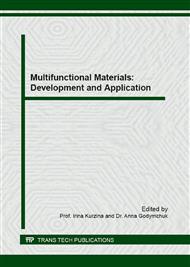[1]
C. Sarra-Bournet, B. Haberl, C. Charles, R. Boswel, Characterization of nanocrystalline nitrogen-containing titanium oxide obtained by N2/O2/Ar low-field helicon plasma sputtering, J. Phys. D: Appl. Phys. 44 (2012) 1-8.
DOI: 10.1088/0022-3727/44/45/455202
Google Scholar
[2]
M.E. Konischev, O.S. Kuzmin, A.A. Pustovalova, N.S. Morozova, K.E. Evdokimov et al., Structure and properties of Ti-O-N coatings produced by reactive magnetron sputtering, Russ. Phys. J. 56 (2014) 1144-1149.
DOI: 10.1007/s11182-014-0154-5
Google Scholar
[3]
Z.F. Yin, L. Wu, H.G. Yang and Y.H. Su, Recent progress in biomedical applications of titanium dioxide, Phys. Chem. Chem. Phys. 15 (2013) 4844-4858.
DOI: 10.1039/c3cp43938k
Google Scholar
[4]
N. Huang, P. Yang, Y.X. Leng, J.Y. Chen, H. Sun, J. Wang, G.J. Wang, P.D. Ding, T.F. Xi, Y. Leng, Hemocompatibility of titanium oxide films, Biomaterials. 24 (2003) 2177-2187.
DOI: 10.1016/s0142-9612(03)00046-2
Google Scholar
[5]
F. López-Huerta, B. Cervantes, O. González, J. Hernández-Torres, L. García-González, R. Vega, A. L. Herrera-May, E. Soto, Biocompatibility and surface properties of TiO2 thin films deposited by dc magnetron sputtering, Materials. 7 (2014).
DOI: 10.3390/ma7064105
Google Scholar
[6]
I. Tsyganov, M. Maitz, E. Wieser, Blood compatibility of titanium-based coatings prepared by metal plasma immersion ion implantation and deposotion, Appl. Surf. Sci. 235 (2004) 156-63.
DOI: 10.1016/j.apsusc.2004.05.134
Google Scholar
[7]
S. Forberg, Ceramic containers for spent nuclear fuel: on the corrosion resistance of rutile, J. Adv. Ceram. 20 (1986) 321-327.
Google Scholar
[8]
L.F. Arias, A. Kleiman, E. Heredia, A. Márquez, Rutile titanium dioxide films deposited with a vacuum arc at different temperatures, Journal of Physics: Conference Series. 370 (2012) 1-5.
DOI: 10.1088/1742-6596/370/1/012027
Google Scholar
[9]
J. Ananpattarachai, P. Kajitvichyanukul, S. Seraphind, Visible light absorption ability and photocatalytic oxidation activity of various interstitial N-doped TiO2 prepared from different nitrogen dopants, J. Hazard. Mater. 168 (2009) 253-261.
DOI: 10.1016/j.jhazmat.2009.02.036
Google Scholar
[10]
R. Gago, A. Redondo-Cubero, M. Vinnichenko, J. Lehmann, F. Munnik, F.J. Palomares, Spectroscopic evidence of NOx formation and band-gap narrowing in N-doped TiO2 films grown by pulsed magnetron sputtering, Mater. Chem. Phys. 136 (2012) 729-736.
DOI: 10.1016/j.matchemphys.2012.07.049
Google Scholar
[11]
R. Pandian, G. Natarajan, S. Rajagopalan, M. Kamruddin, A. Tyagi, On the phase formation of titanium oxide thin films deposited by reactive dc magnetron sputtering: influence of oxygen partial pressure and nitrogen doping, Appl. Phys. A. 116 (2014).
DOI: 10.1007/s00339-014-8351-1
Google Scholar
[12]
V. Babu, A. Nair, Z. Peining, S. Ramakrishna, Synthesis and characterization of rice grains like nitrogen-doped TiO2 nanostructures by electrospinning-photocatalysis, Mater. Lett. 65 (2011) 3064-3068.
DOI: 10.1016/j.matlet.2011.06.035
Google Scholar
[13]
J. Li, Y. Wang, L. Wang, Structure and properties of nitrogen incorporated in TiO2 nanotubes array, Mater. Res. Express. 1 (2014) 1-10.
Google Scholar
[14]
Information on http: /webbook. nist. gov/chemistry.
Google Scholar
[15]
G.V. Arysheva, N.M. Ivanova, M.E. Konishchev, A.A. Pustovalova, V.S. Sypchenko, Analysis of magnetron-deposited titanium oxynitride coatings by scanning electron microscopy and raman scattering, Adv. Mater. Res. 1084 (2015) 3-6.
DOI: 10.4028/www.scientific.net/amr.1084.3
Google Scholar
[16]
R.S. Vemuri, M. Noor-A-Alam, S.K. Gullapalli et. al., Nitrogen-incorporation induced changes in the microstructure of nanocrystalline WO3 thin films, Thin Solid Films. 520 (2011) 1446-1450.
DOI: 10.1016/j.tsf.2011.08.080
Google Scholar
[17]
G.V. Arysheva, N.M. Ivanova, A.A. Pustovalova, M.E. Konishchev, Surface morphology of titanium oxide and oxynitride coatings deposited by reactive magnetron sputtering, Adv. Mater. Res. 1085 (2015) 134-138.
DOI: 10.4028/www.scientific.net/amr.1085.134
Google Scholar
[18]
K. Liu, L. Zhu, T. Jiang, Y. Sun, H. Li, D. Wang, Mesoporous TiO2 micro-nanometer composite structure: synthesis, optoelectric properties, and photocatalytic selectivity, Int. J. Photoenergy. (2012) 1-9.
DOI: 10.1155/2012/849062
Google Scholar
[19]
G. Yang, Z. Jiang, H. Shi, T. Xiao, Z. Yan, Preparation of highly visible-light active N-doped TiO2 photocatalyst, J. Mater. Chem. 20 (2010) 5301-5309.
DOI: 10.1039/c0jm00376j
Google Scholar


